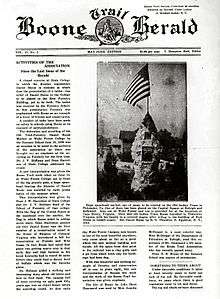Boone Trail
Between 1913 and 1938, J.(Joseph) Hampton Rich, a resident of Mocksville, North Carolina, USA took it upon himself to keep the memory of Daniel Boone and his travels alive. He did this by placing 358 metal tablets between Virginia Beach, Virginia and San Francisco, California. Although many of the tablets are associated with locations visited by Boone, many were simply placed wherever Mr. Rich could collect the necessary donations from schools, communities, etc. to erect a monument. He established the Boone Trail Highway Association to further his project. From the mid-1920s to the mid-1930s, the Association published a newsletter which detailed the efforts to install new monuments.

The markers also have a link to more recent history. Supposedly, the tablets were (at least partially) constructed from metal salvaged from the battleship USS Maine (ACR-1), which was sunk during the Spanish–American War in 1898. Typically, the tablets were located near schools, government buildings, or along old highway routes. Over the years, many of the markers have been lost to highway construction and general urban sprawl.
In the late-1990s, a group of descendants of Daniel Boone established the Boone Trail Highway & Memorial Re-Association with the intent of locating the markers which remained. Approximately 60 tablets have been located thus far. One of the tablets can be found on Franklin Street in Chapel Hill, North Carolina. Another can be found in front of historic Old Main on the campus of The University of North Carolina at Pembroke in Pembroke, North Carolina.
References
- Rich Man: Daniel Boone by Everette G. Marshall (Sugar Tree Enterprises, 2003)
External links
- "Boone Trail Highway Markers". Archived from the original on 2007-08-19. Retrieved 2006-03-22. – a search for markers that had its last update in 2006.
- Marker at The University of North Carolina at Pembroke